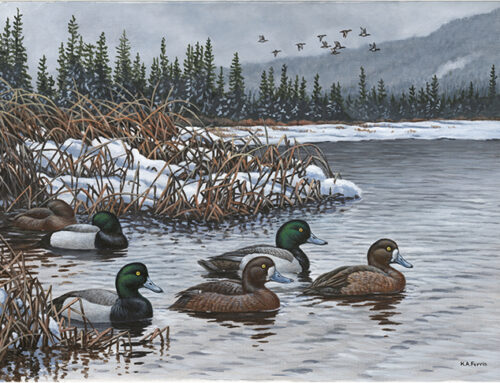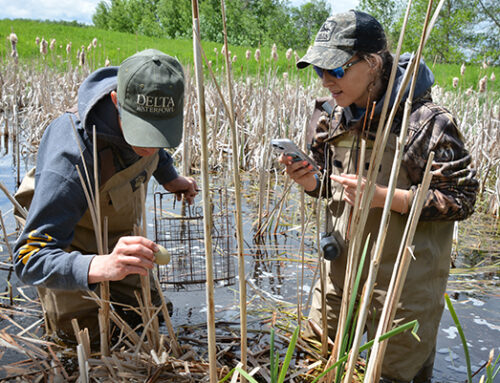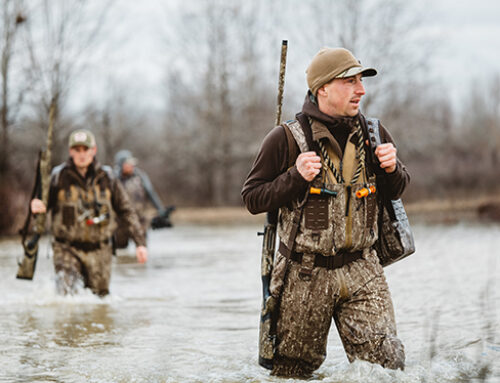State Breeding Waterfowl Surveys Spur Optimism for Upcoming Hunting Seasons

Duck and goose hunters anxiously await results from the comprehensive 2022 Waterfowl Breeding Population and Habitat Survey, which will return this year after being cancelled in 2020 and 2021 because of concerns surrounding COVID-19. Survey results are expected from U.S. Fish and Wildlife Service later this month.
Although much of the western continental United States is mired in drought, wetland habitat conditions in the Prairie Pothole Region improved remarkably for the 2022 waterfowl breeding season. Duck production should be good across key areas of the prairies this year, with more young ducks in the fall flight.
Delta Waterfowl will provide extensive analysis as soon as the USFWS results are available.
Meanwhile, a number of states have released results from their own 2022 independent breeding population surveys. Following is a roundup of those state survey results.
North Dakota — After being abnormally dry in 2021, the state’s spring water index showed conditions are the second-wettest in the 75-year history of the North Dakota Fish and Game Department survey — up 616 percent from 2021. Major snow events and prolonged soaking rains this winter and spring — April had the second-most precipitation recorded in the past 128 years — recharged parched wetlands throughout the state. The abundance of water across North Dakota is excellent news for breeding ducks, and in turn, for duck hunters.
“The really wet conditions will help in inciting nesting and continuing that effort throughout spring,” said Mike Szymanski, migratory game bird supervisor for the NDFGD. “Ponds that are important for brood-rearing habitat have rebounded nicely. Things are looking pretty good for duck production prospects.”
The survey showed 3.4 million total ducks, a 16 percent increase from 2021. Duck numbers for North Dakota are 38 percent above the long-term average. Mallards increased 58 percent, while pintails were up 108 percent and shovelers registered 126 percent higher than last year. Most species showed increases, although blue-winged teal were down 4 percent, wigeon were 10 percent lower and gadwalls declined by 36 percent.
Numbers of breeding Canada geese in North Dakota were the second highest ever recorded, although a late-April blizzard likely hurt nesting efforts. Geese nest earlier than ducks, so production might be lower as a result of the storm.
North Dakota is the leading state for duck production, so a strong breeding effort will feed ducks to all four flyways.
“It’ll be exciting to compare the North Dakota survey results to the broader federal survey this year,” said Dr. Chris Nicolai, waterfowl scientist for Delta Waterfowl. “There’s a very high potential for banner duck production, especially for prairie nesting ducks such as mallards, pintails, blue-winged teal, shovelers, gadwalls and redheads.”

Minnesota — Much like North Dakota, Minnesota was really wet this spring. The state experienced its fourth-wettest spring since 1968. Wetland numbers were 19% higher than 2019 (no survey in 2020 or 2021), and 21% above the 10-year average. As a result, duck production should be good across Minnesota.
Breeding duck numbers, which reflect recruitment from previous breeding years, are down. The survey estimates 606,884 ducks, a 17% decline from 2019 and 11% below the long-term average.
Mallards were estimated at 231,058, a 19% decrease from 2019 and 9% below the 10-year average. Blue-winged teal checked in at 161,395, a 28% drop from 2019 that is 24% below the long-term average. The survey notes suggest that a late, cold spring in 2022 could have resulted in a lower count of blue-winged teal. Wood ducks, ring-necked ducks and scaup were all up from 2019 estimates.
Canada geese tracked at 114,981, up 4% from 2019, but 27% below the long-term average.

Wisconsin — Breeding habitat conditions in the Badger State this May were exceptionally wet. The 2022 estimate of 591,762 breeding ducks is the state’s highest since 2005, and fourth-highest estimate in the past 50 years. The 2022 estimate is 33.6% higher than the long-term mean.
Mallards are estimated at 181,686, a 3.3% increase over 2021 and 1.5% higher than the long-term mean. Wood ducks dropped 8.4% to 174,526, however, they’re still 102.2% above the long-term mean. Wood duck populations have shown an increasing trend during the past five years. Blue-winged teal increased to 81,359, up 9% this spring, but still 22.1% below the long-term mean.
Canada geese continue to increase, with an estimated breeding population of 180,340, the highest recorded since the species was included in the survey beginning in 1986. The 2022 population climbed 3.3%, and sits 68.2% above the long-term mean.

Michigan — The state’s wetland abundance index showed 493,144 wetlands, a 2% decline from 2021, but still 2% above the long-term average since 1991. Conditions were characterized as good to excellent statewide, except for portions of northwestern Lower Peninsula that were dry this spring.
Duck numbers were significantly lower, with total ducks estimated at 202,026, a 79% decline from 2021 and 68% below the long-term average. The 2022 mallard estimate stands at 138,713, a drop of 55%.
Canada goose estimates also plummeted. The 2022 survey puts the breeding population at 196,204, a 34% decline over the previous year. The estimate is 16% below the long-term average. On a positive note, invasive mute swans declined by 10%, a sign that control efforts are working.

Oregon — Rather surprisingly given dry conditions, Oregon’s survey results showed a 32.2% increase in total ducks from 2021. However, most of that increase is a result of large flocks of shovelers, ruddy ducks, green-winged teal and buffleheads that were likely still migrating through the state when the survey was conducted this spring.
Mallards, gadwalls and cinnamon teal are Oregon’s three most abundant nesting duck species. Mallards were estimated at 79,388, which is up 4.1% from 2021, but 11.8% below the long-term average. Gadwall were estimated at 46,166, a significant 28.9% decline from 2021 and 14.1% below the long-term average. Cinnamon teal numbers also declined a sharp 17.1% from 2021, sitting 35.9% below the long-term average for the species.
“Surprisingly, after significant drought and poor production in 2021 (measured by age ratios during banding last summer), the statewide mallard estimate increased, likely due to good habitat conditions in western Oregon and increased indices there. Mallard indices in eastern Oregon (southeast seasonal marsh, northeast seasonal marsh and the forested wetlands strata) were all down from 2021 and the long-term average, as expected,” according to Brandon Reishus, migratory game bird coordinator for the Oregon Department of Fish and Wildlife.
Canada geese estimates dropped to 44,711, a 16.9% decrease from 2021.

California — Exceptional drought conditions continue to severely hamper duck production. Spring precipitation totals ranged from 66% to 89% below average, driving a decline of local breeding duck populations.
Total breeding ducks were estimated at 379,872, a 19% decrease from 2019 (California did not conduct surveys in 2020 or 2021 because of COVID-19 concerns) and 30% below the long-term average.
Mallards were estimated at 179,393, a 25% drop from 2019 and 45% lower than the long-term average. Gadwalls also declined significantly, off 31% from 2019 and 11% below the long-term average. Cinnamon teal numbers plummeted by 54% from 2019, and register at 46% below the long-term average.
Canada geese numbers were less affected by the drought conditions. Geese estimates showed 46,359, a decrease of 5% from 2019, but 4% above the long-term average.






Leave A Comment